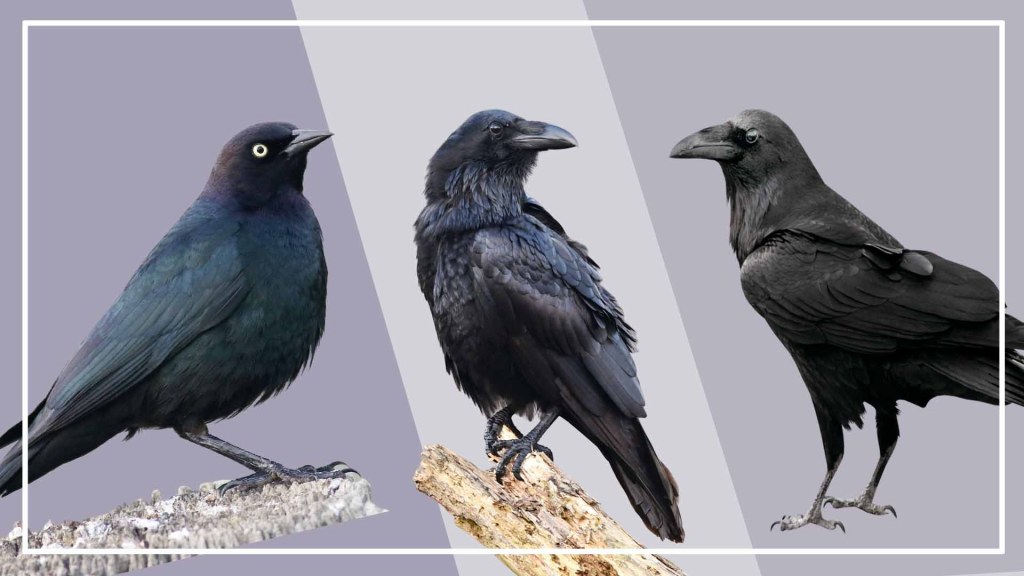The Mighty Trio: Blackbird, Crow, And Raven – Unleash The Power Within!
Exploring the Mysteries of Blackbird, Crow, and Raven: A Comprehensive Guide
Introduction
Welcome, Raven Enthusiast! In this comprehensive guide, we will delve into the fascinating world of blackbirds, crows, and ravens. These intelligent and charismatic birds have long captured the human imagination with their dark beauty and mysterious behavior. Join us as we uncover the secrets behind these avian wonders and gain a deeper understanding of their significance in various cultures and ecosystems.
1 Picture Gallery: The Mighty Trio: Blackbird, Crow, And Raven – Unleash The Power Within!

Table of Contents:
Overview of Blackbird, Crow, and Raven
The Difference Between Blackbirds, Crows, and Ravens
The Habitat and Distribution of Blackbirds, Crows, and Ravens
The Life Cycle and Behavior of Blackbirds, Crows, and Ravens
The Cultural Significance of Blackbirds, Crows, and Ravens
The Role of Blackbirds, Crows, and Ravens in Ecosystems
Conservation Efforts and Threats to Blackbirds, Crows, and Ravens
FAQs
Conclusion
Final Remarks
1. Overview of Blackbird, Crow, and Raven

Image Source: petdemy.com
Blackbirds, crows, and ravens are members of the passerine bird family, known as the Corvidae family. They belong to the order Passeriformes, which includes more than 5,000 species of birds. These birds are known for their striking black plumage, high intelligence, and adaptability.
Blackbirds, crows, and ravens are found in various parts of the world, with different species thriving in different habitats. They play important roles in maintaining ecological balance and have also inspired numerous myths, legends, and cultural beliefs.
Let’s now explore the distinctive characteristics and behaviors of each of these fascinating birds.
2. The Difference Between Blackbirds, Crows, and Ravens
While blackbirds, crows, and ravens may appear similar at first glance, there are several key differences that set them apart.
Blackbirds, such as the Common Blackbird and Red-winged Blackbird, are smaller in size and have melodious songs. They are primarily insectivorous and are known for their beautiful black feathers with iridescent sheens.
Crows, on the other hand, are larger and more gregarious. They are known for their distinctive cawing sounds and their ability to adapt to various environments. American Crows and Carrion Crows are among the most well-known species.
Ravens, the largest of the three, have a more robust build and are known for their deep, guttural croaking calls. They possess impressive problem-solving skills and are often associated with wisdom, magic, and symbolism in many cultures. The Common Raven and White-necked Raven are prominent species.
Despite these differences, all three birds share certain characteristics, such as their high intelligence and adaptability.
3. The Habitat and Distribution of Blackbirds, Crows, and Ravens
Blackbirds, crows, and ravens can be found in a wide range of habitats, from forests and grasslands to urban areas. They have adapted well to human-dominated environments and can often be seen foraging in parks, gardens, and even garbage dumps.
The distribution of these birds varies depending on the species. For example, the Common Blackbird is native to Europe, while the American Crow is found across North America. Ravens, on the other hand, have a more widespread distribution, with species found in Europe, Asia, and North America.
Each species has its own preferences when it comes to nesting and foraging, but they are all highly adaptable and can thrive in diverse environments.
4. The Life Cycle and Behavior of Blackbirds, Crows, and Ravens
The life cycle of blackbirds, crows, and ravens begins with courtship displays and mating rituals. These birds are monogamous and form strong pair bonds that can last for many years.
After mating, the female builds a nest using twigs, grass, and other materials. The nests are usually located in trees or other elevated structures. The female lays eggs, which are then incubated by both parents. Once the eggs hatch, the parents take turns feeding and caring for the chicks until they are ready to leave the nest.
Blackbirds, crows, and ravens are highly social birds and often form large flocks, especially during the non-breeding season. They communicate through a variety of vocalizations and body language, displaying complex social dynamics and cooperative behaviors.
These birds are also known for their problem-solving skills and use tools to obtain food. Their intelligence and adaptability have been the subject of numerous scientific studies.
5. The Cultural Significance of Blackbirds, Crows, and Ravens
Blackbirds, crows, and ravens have long captivated human imagination and have been featured in myths, folklore, and literature across different cultures.
In some cultures, blackbirds are associated with good luck and protection, while in others they are seen as omens of bad fortune. Crows and ravens have often been depicted as symbols of death, darkness, and mystery. However, they have also been revered as symbols of wisdom, intelligence, and spiritual guidance.
The cultural significance of these birds extends beyond symbolism. They have inspired artists, writers, and musicians throughout history and continue to be a source of inspiration in contemporary art and literature.
6. The Role of Blackbirds, Crows, and Ravens in Ecosystems
Blackbirds, crows, and ravens play crucial roles in maintaining the ecological balance of their respective habitats.
As omnivores, these birds feed on a wide variety of food sources, including insects, small mammals, fruits, seeds, and carrion. They are opportunistic scavengers and help control populations of pests and carrion, thereby playing a vital role in keeping ecosystems healthy.
Their foraging behaviors also contribute to seed dispersal, aiding in the regeneration of forests and other habitats. Additionally, these birds are important indicators of environmental health, as changes in their populations can reflect shifts in ecological conditions.
7. Conservation Efforts and Threats to Blackbirds, Crows, and Ravens
While blackbirds, crows, and ravens are adaptable species, they face various threats in the modern world.
Habitat loss, due to urbanization and deforestation, poses a significant threat to these birds. Pollution, climate change, and the use of pesticides also negatively impact their populations.
Conservation efforts are underway to protect these birds and their habitats. These include habitat restoration, captive breeding programs, and public awareness campaigns to promote responsible bird-watching and conservation practices.
FAQs
1. Are crows and ravens the same bird?
2. Do blackbirds migrate?
3. Can blackbirds mimic human speech?
4. What is the lifespan of blackbirds, crows, and ravens?
5. How can I attract blackbirds, crows, or ravens to my garden?
Conclusion
Blackbirds, crows, and ravens are truly remarkable creatures that have fascinated humans for centuries. From their intelligence and adaptability to their cultural significance and ecological roles, these birds embody the beauty and mystery of the natural world.
By understanding and appreciating these birds, we can contribute to their conservation and ensure that future generations can continue to marvel at their presence in our lives.
Final Remarks
In conclusion, exploring the world of blackbirds, crows, and ravens is an enriching experience that deepens our connection with nature and expands our understanding of the avian kingdom. As we continue to learn more about these remarkable creatures, let us remember to appreciate their beauty, protect their habitats, and promote their well-being in every way we can. Together, we can ensure a harmonious coexistence between humans and these intelligent feathered beings.
This post topic: Raven



